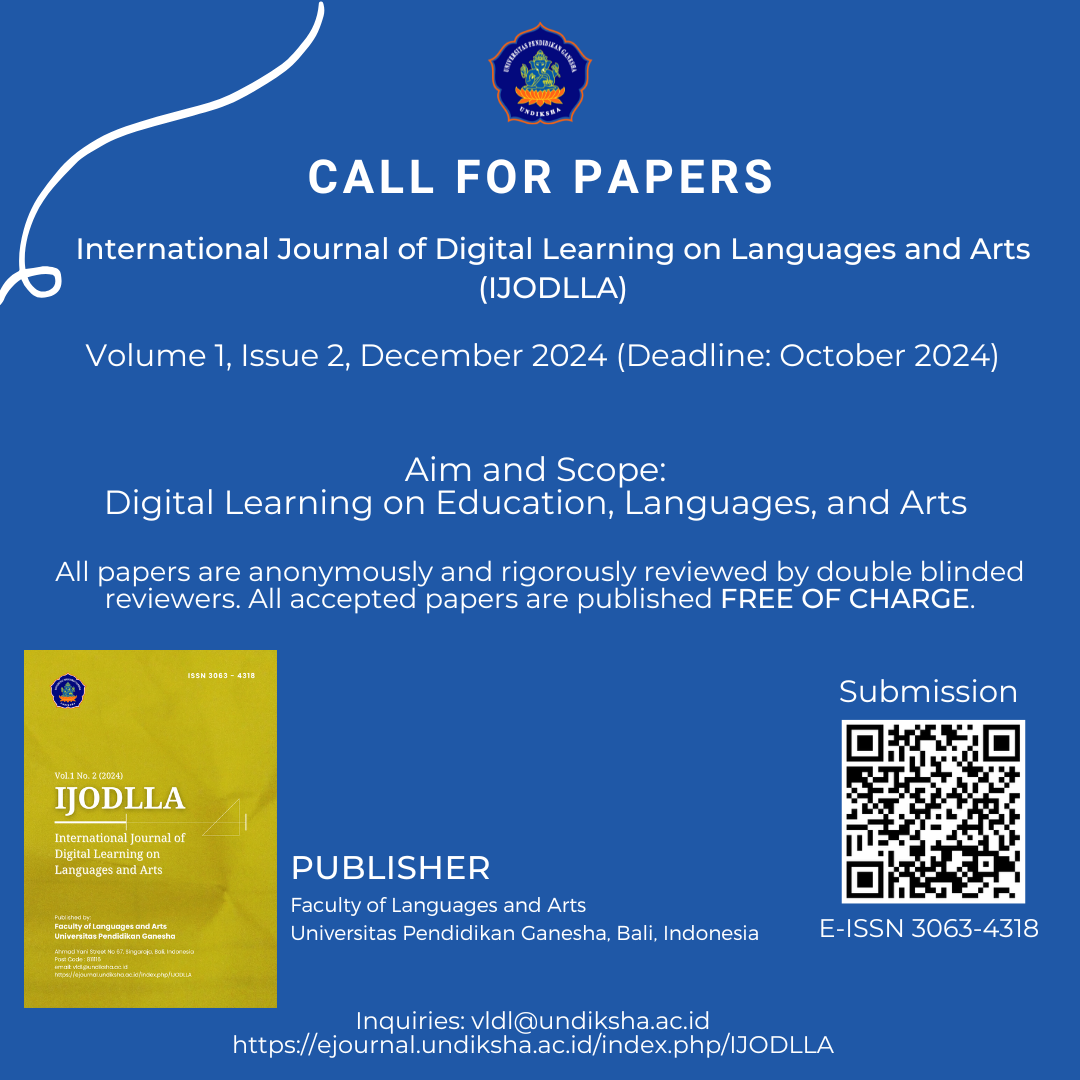The Effect of Gamification of Four-Grade Students’ Writing Competency
DOI:
https://doi.org/10.23887/ijodlla.v1i1.83508Keywords:
Gamification, EFL, Writing, Young LearnersAbstract
This research aims to determine the effect of gamification on fourth grade students' writing competence. This study was an experimental study conducted at SD N 4 Banyuasri, Buleleng, Bali. Using pretest posttest design, this study involved four grade students as the sample of the study. Data collection in this research used several instruments, namely tests (pre-test and post-test), lesson plans, and rubric for analyzing writing. The results of the study found that the post-test score (M= 82.86, Std= 7.507) was higher than the pre-test (M= 42.32, Std= 14.368). The t test results also confirmed that there was a significant difference in the mean score between the pre-test and post-test (Sig≤0.05). During the learning process, students look active and motivated while participating in the learning process in class. This study also present an important discussions towards using gamification in creating motivating and engaging learing environment.
References
Abusa’aleek, R. A., & Baniabdelrahman, A. A. (2020). The Effect of Gamification on Jordanian EFL Sixth Grade Students’ Reading Comprehension. International Journal of Education and Training (InjET), 6(1), 1–11.
Aljraiwi, S. (2019). Effectiveness of gamification of web-based learning in improving academic achievement and creative thinking among primary school students. International Journal of Education and Practice, 7(3), 242–257. https://doi.org/10.18488/journal.61.2019.73.242.257
Burston, J. (2014). MALL: The pedagogical challenges. Computer Assisted Language Learning, 27(4), 344–357. https://doi.org/10.1080/09588221.2014.914539
Courtney, L., & Graham, S. (2019). “It’s like having a test but in a fun way” Young learners’ perceptions of a digital game-based assessment of early language learning. Language Teaching for Young Learners, 1(2), 161–186. https://doi.org/10.1075/ltyl.18009.cou
Deterding, S., Dixon, D., Khaled, R., & Nacke, L. (2011). From game design elements to gamefulness: Defining “gamification.” Proceedings of the 15th International Academic MindTrek Conference: Envisioning Future Media Environments, MindTrek 2011, March 2014, 9–15. https://doi.org/10.1145/2181037.2181040
EFI. (2019). Indeks Kecakapan Bahasa Inggris EF. https://www.ef.co.id/epi/regions/asia/indonesia/
Fajrina, D., Everatt, J., & Sadeghi, A. (2021). Writing Strategies Used by Indonesian EFL Students with Different English Proficiency. Language Teaching Research Quarterly, 21, 1–15. https://doi.org/10.32038/ltrq.2021.21.01
Godwin-Jones, R. (2014). Games in language learning: Opportunities and challenges. Language Learning and Technology, 18(2), 9–19.
Hadi, M. S., & Athallah, N. (2020). Efektifitas Gamifikasi Dalam Mengajar Bahasa. Seminar Nasional Penelitian.
Hasanudin, C., Subyantoro, S., Zulaeha, I., & Pristiwati, R. (2021). Strategi Menyusun Bahan Ajar Inovatif Berbasis Mobile Learning untuk Pembelajaran Mata Kuliah Keterampilan Menulis di Abad 21. Prosiding Seminar Nasional Pascasarjana, 343–347.
Hsu, L. (2016). Examining EFL teachers’ technological pedagogical content knowledge and the adoption of mobile-assisted language learning: a partial least square approach. Computer Assisted Language Learning, 29(8), 1287–1297. https://doi.org/10.1080/09588221.2016.1278024
Jefiza, A. (2016). Young Learners’ Problems in English Writing. Jurnal Tarbiyah, 23(1), 139–141.
Lin, J. (2022). Machine Translated by Google Pengaruh Pembelajaran Gamifikasi Terhadap Peran Persepsi Kemudahan Belajar , Kesenangan , dan Ilmu yang Bermanfaat terhadap Sikap Belajar. 21(April), 81–91.
Marin-Pacurucu, B. A., & Argudo-Garzón, A. L. (2022). Gamification strategies and speaking fluency in EFL elementary students. Iustitia Socialis, 7(1), 77. https://doi.org/10.35381/racji.v7i1.1702
Mudra, H. (2020). Digital Literacy Among Young Learners: How Do Efl Teachers and Learners View Its Benefits and Barriers? Teaching English with Technology, 20(3), 3–24.
Mutholib, A., Munjiah, M., & Agny Anggara, S. (2023). The use of gamification in teaching writing skills to junior high students. Ta’lim Al-’Arabiyyah: Jurnal Pendidikan Bahasa Arab Dan Kebahasaaraban, 7(1), 73–87.
Padri, M., Cicilia, Y., & Nursalim, N. (2020). Kompetensi Bahasa dan Kompetensi Komunikatif Peserta Didik. Instructional Development Journal, 3(1), 49. https://doi.org/10.24014/idj.v3i1.9529
Permana, I. G. Y., Rismadewi, N. W. M., & Putra, N. C. A. (2024). Gamification in EFL Classroom : Results of Implementation and Teachers ’ Point of View. Journal of Ultimate Research and Trends in Education, 6(1), 1–11. https://doi.org/https://doi.org/10.31849/utamax.v6i1.19297
Pingmuang, P., & Koraneekij, P. (2022). Mobile-assisted language learning using task-based approach and gamification for enhancing writing skills in EFL students. Electronic Journal of E-Learning, 20(5), 623–638. https://doi.org/10.34190/ejel.20.5.2339
Rahmani, E. F. (2020). The benefits of gamification in the English learning context. IJEE (Indonesian Journal of English Education), 7(1), 32–47. https://doi.org/10.15408/ijee.v7i1.17054
Samosa, R. C., Policarpio, M. V, Caňamaque, B. O., Honeylyn Camocamo, P. A., & Marie Clavito, J. E. (2021). Gamification as an innovative strategy to improve learners’ writing skills. International Journal of Academic Multidisciplinary Research, 5(12), 25–32. www.ijeais.org/ijamr
Taghizadeh, M., & Hasani Yourdshahi, Z. (2020). Integrating technology into young learners’ classes: language teachers’ perceptions. Computer Assisted Language Learning, 33(8), 982–1006. https://doi.org/10.1080/09588221.2019.1618876
Tahir, M. H. M., Martin, S. G. A., & Mohammad, H. H. (2022). The knight’s quest: The effectiveness of virtual gamification for listening skills activity in English language. E-Proceedings of Innovation, Product Launching and Entrepreneurship (INNOPLEN) 2022, 102–104.
Zhihao, Z., & Zhonggen, Y. (2022). The Impact of Gamification on the Time-Limited Writing Performance of English Majors. Education Research International, 2022. https://doi.org/10.1155/2022/4650166
Downloads
Published
How to Cite
Issue
Section
License

This work is licensed under a Creative Commons Attribution-ShareAlike 4.0 International License.









